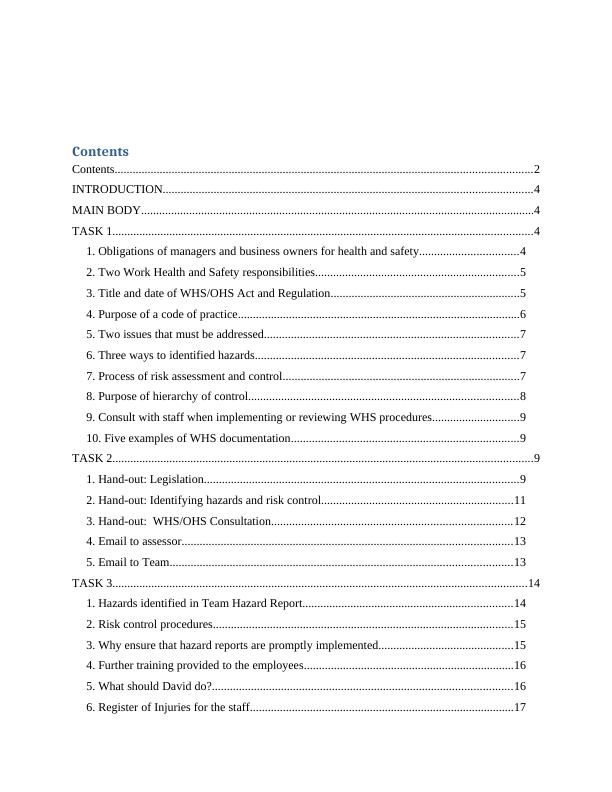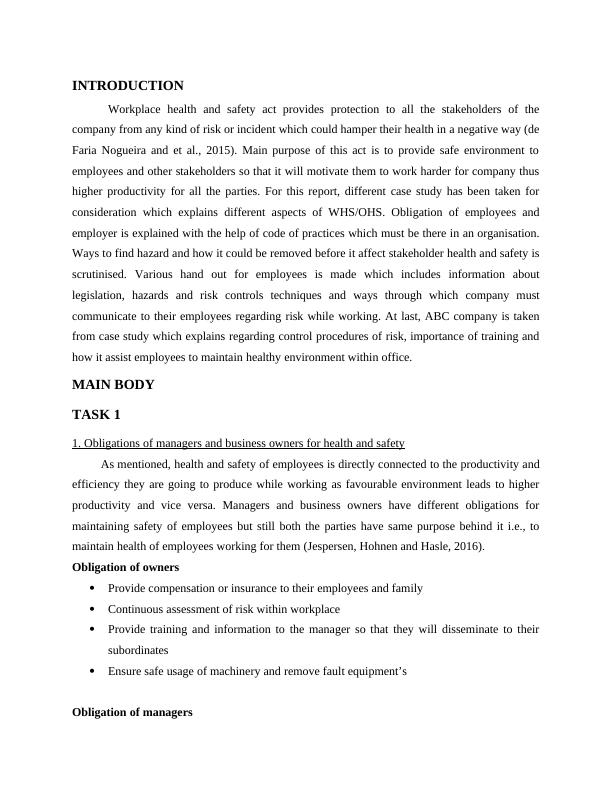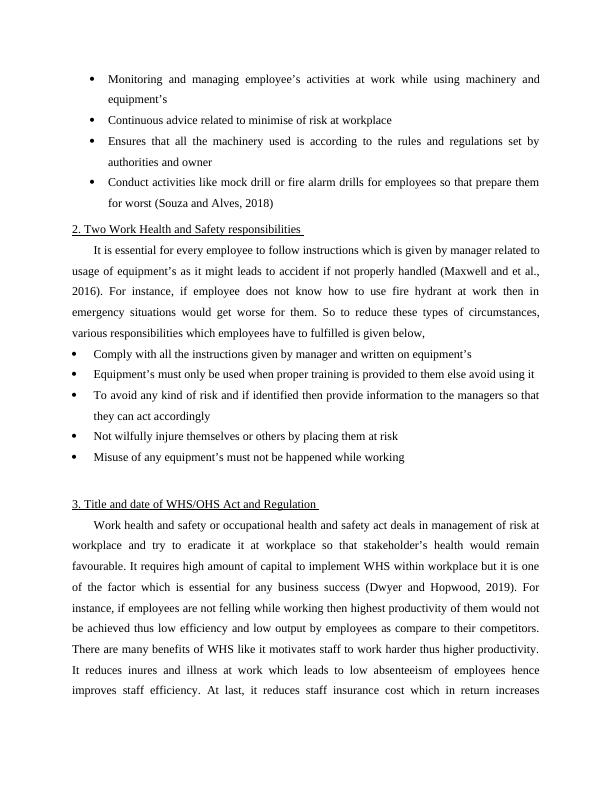Workplace Health and Safety Act | Case Study Report
Implement operational plan for Boutique Build Australia including recruitment, selection, and induction policy and procedures.
24 Pages7442 Words32 Views
Added on 2022-09-12
Workplace Health and Safety Act | Case Study Report
Implement operational plan for Boutique Build Australia including recruitment, selection, and induction policy and procedures.
Added on 2022-09-12
ShareRelated Documents
Implement and Monitor WHS Policies,
Procedures and Programs to meet Legislative
Requirements
Procedures and Programs to meet Legislative
Requirements

Contents
Contents...........................................................................................................................................2
INTRODUCTION...........................................................................................................................4
MAIN BODY...................................................................................................................................4
TASK 1............................................................................................................................................4
1. Obligations of managers and business owners for health and safety.................................4
2. Two Work Health and Safety responsibilities....................................................................5
3. Title and date of WHS/OHS Act and Regulation...............................................................5
4. Purpose of a code of practice..............................................................................................6
5. Two issues that must be addressed.....................................................................................7
6. Three ways to identified hazards........................................................................................7
7. Process of risk assessment and control...............................................................................7
8. Purpose of hierarchy of control..........................................................................................8
9. Consult with staff when implementing or reviewing WHS procedures.............................9
10. Five examples of WHS documentation............................................................................9
TASK 2............................................................................................................................................9
1. Hand-out: Legislation.........................................................................................................9
2. Hand-out: Identifying hazards and risk control................................................................11
3. Hand-out: WHS/OHS Consultation................................................................................12
4. Email to assessor..............................................................................................................13
5. Email to Team..................................................................................................................13
TASK 3..........................................................................................................................................14
1. Hazards identified in Team Hazard Report......................................................................14
2. Risk control procedures....................................................................................................15
3. Why ensure that hazard reports are promptly implemented.............................................15
4. Further training provided to the employees......................................................................16
5. What should David do?....................................................................................................16
6. Register of Injuries for the staff........................................................................................17
Contents...........................................................................................................................................2
INTRODUCTION...........................................................................................................................4
MAIN BODY...................................................................................................................................4
TASK 1............................................................................................................................................4
1. Obligations of managers and business owners for health and safety.................................4
2. Two Work Health and Safety responsibilities....................................................................5
3. Title and date of WHS/OHS Act and Regulation...............................................................5
4. Purpose of a code of practice..............................................................................................6
5. Two issues that must be addressed.....................................................................................7
6. Three ways to identified hazards........................................................................................7
7. Process of risk assessment and control...............................................................................7
8. Purpose of hierarchy of control..........................................................................................8
9. Consult with staff when implementing or reviewing WHS procedures.............................9
10. Five examples of WHS documentation............................................................................9
TASK 2............................................................................................................................................9
1. Hand-out: Legislation.........................................................................................................9
2. Hand-out: Identifying hazards and risk control................................................................11
3. Hand-out: WHS/OHS Consultation................................................................................12
4. Email to assessor..............................................................................................................13
5. Email to Team..................................................................................................................13
TASK 3..........................................................................................................................................14
1. Hazards identified in Team Hazard Report......................................................................14
2. Risk control procedures....................................................................................................15
3. Why ensure that hazard reports are promptly implemented.............................................15
4. Further training provided to the employees......................................................................16
5. What should David do?....................................................................................................16
6. Register of Injuries for the staff........................................................................................17

7. Which health and safety issue is important......................................................................20
8. Risk controls would you change.......................................................................................20
9. What should the manager do............................................................................................21
CONCLUSION..............................................................................................................................21
REFERENCES..............................................................................................................................22
8. Risk controls would you change.......................................................................................20
9. What should the manager do............................................................................................21
CONCLUSION..............................................................................................................................21
REFERENCES..............................................................................................................................22

INTRODUCTION
Workplace health and safety act provides protection to all the stakeholders of the
company from any kind of risk or incident which could hamper their health in a negative way (de
Faria Nogueira and et al., 2015). Main purpose of this act is to provide safe environment to
employees and other stakeholders so that it will motivate them to work harder for company thus
higher productivity for all the parties. For this report, different case study has been taken for
consideration which explains different aspects of WHS/OHS. Obligation of employees and
employer is explained with the help of code of practices which must be there in an organisation.
Ways to find hazard and how it could be removed before it affect stakeholder health and safety is
scrutinised. Various hand out for employees is made which includes information about
legislation, hazards and risk controls techniques and ways through which company must
communicate to their employees regarding risk while working. At last, ABC company is taken
from case study which explains regarding control procedures of risk, importance of training and
how it assist employees to maintain healthy environment within office.
MAIN BODY
TASK 1
1. Obligations of managers and business owners for health and safety
As mentioned, health and safety of employees is directly connected to the productivity and
efficiency they are going to produce while working as favourable environment leads to higher
productivity and vice versa. Managers and business owners have different obligations for
maintaining safety of employees but still both the parties have same purpose behind it i.e., to
maintain health of employees working for them (Jespersen, Hohnen and Hasle, 2016).
Obligation of owners
Provide compensation or insurance to their employees and family
Continuous assessment of risk within workplace
Provide training and information to the manager so that they will disseminate to their
subordinates
Ensure safe usage of machinery and remove fault equipment’s
Obligation of managers
Workplace health and safety act provides protection to all the stakeholders of the
company from any kind of risk or incident which could hamper their health in a negative way (de
Faria Nogueira and et al., 2015). Main purpose of this act is to provide safe environment to
employees and other stakeholders so that it will motivate them to work harder for company thus
higher productivity for all the parties. For this report, different case study has been taken for
consideration which explains different aspects of WHS/OHS. Obligation of employees and
employer is explained with the help of code of practices which must be there in an organisation.
Ways to find hazard and how it could be removed before it affect stakeholder health and safety is
scrutinised. Various hand out for employees is made which includes information about
legislation, hazards and risk controls techniques and ways through which company must
communicate to their employees regarding risk while working. At last, ABC company is taken
from case study which explains regarding control procedures of risk, importance of training and
how it assist employees to maintain healthy environment within office.
MAIN BODY
TASK 1
1. Obligations of managers and business owners for health and safety
As mentioned, health and safety of employees is directly connected to the productivity and
efficiency they are going to produce while working as favourable environment leads to higher
productivity and vice versa. Managers and business owners have different obligations for
maintaining safety of employees but still both the parties have same purpose behind it i.e., to
maintain health of employees working for them (Jespersen, Hohnen and Hasle, 2016).
Obligation of owners
Provide compensation or insurance to their employees and family
Continuous assessment of risk within workplace
Provide training and information to the manager so that they will disseminate to their
subordinates
Ensure safe usage of machinery and remove fault equipment’s
Obligation of managers

Monitoring and managing employee’s activities at work while using machinery and
equipment’s
Continuous advice related to minimise of risk at workplace
Ensures that all the machinery used is according to the rules and regulations set by
authorities and owner
Conduct activities like mock drill or fire alarm drills for employees so that prepare them
for worst (Souza and Alves, 2018)
2. Two Work Health and Safety responsibilities
It is essential for every employee to follow instructions which is given by manager related to
usage of equipment’s as it might leads to accident if not properly handled (Maxwell and et al.,
2016). For instance, if employee does not know how to use fire hydrant at work then in
emergency situations would get worse for them. So to reduce these types of circumstances,
various responsibilities which employees have to fulfilled is given below,
Comply with all the instructions given by manager and written on equipment’s
Equipment’s must only be used when proper training is provided to them else avoid using it
To avoid any kind of risk and if identified then provide information to the managers so that
they can act accordingly
Not wilfully injure themselves or others by placing them at risk
Misuse of any equipment’s must not be happened while working
3. Title and date of WHS/OHS Act and Regulation
Work health and safety or occupational health and safety act deals in management of risk at
workplace and try to eradicate it at workplace so that stakeholder’s health would remain
favourable. It requires high amount of capital to implement WHS within workplace but it is one
of the factor which is essential for any business success (Dwyer and Hopwood, 2019). For
instance, if employees are not felling while working then highest productivity of them would not
be achieved thus low efficiency and low output by employees as compare to their competitors.
There are many benefits of WHS like it motivates staff to work harder thus higher productivity.
It reduces inures and illness at work which leads to low absenteeism of employees hence
improves staff efficiency. At last, it reduces staff insurance cost which in return increases
equipment’s
Continuous advice related to minimise of risk at workplace
Ensures that all the machinery used is according to the rules and regulations set by
authorities and owner
Conduct activities like mock drill or fire alarm drills for employees so that prepare them
for worst (Souza and Alves, 2018)
2. Two Work Health and Safety responsibilities
It is essential for every employee to follow instructions which is given by manager related to
usage of equipment’s as it might leads to accident if not properly handled (Maxwell and et al.,
2016). For instance, if employee does not know how to use fire hydrant at work then in
emergency situations would get worse for them. So to reduce these types of circumstances,
various responsibilities which employees have to fulfilled is given below,
Comply with all the instructions given by manager and written on equipment’s
Equipment’s must only be used when proper training is provided to them else avoid using it
To avoid any kind of risk and if identified then provide information to the managers so that
they can act accordingly
Not wilfully injure themselves or others by placing them at risk
Misuse of any equipment’s must not be happened while working
3. Title and date of WHS/OHS Act and Regulation
Work health and safety or occupational health and safety act deals in management of risk at
workplace and try to eradicate it at workplace so that stakeholder’s health would remain
favourable. It requires high amount of capital to implement WHS within workplace but it is one
of the factor which is essential for any business success (Dwyer and Hopwood, 2019). For
instance, if employees are not felling while working then highest productivity of them would not
be achieved thus low efficiency and low output by employees as compare to their competitors.
There are many benefits of WHS like it motivates staff to work harder thus higher productivity.
It reduces inures and illness at work which leads to low absenteeism of employees hence
improves staff efficiency. At last, it reduces staff insurance cost which in return increases

profitability of company (Maceachen and et al., 2016). WHS laws and regulators is different in
different states and consist of four different components which is give below,
Act: Provide all the responsibilities of employees and employers
Regulations: Set out requirements or minimum criteria of usage of machinery
Code of practice: It includes all the information which is necessary to meet the requirements
of act and regulation
Regular: Governing body or individual who sets WHS at workplace
1 January 2012 is the date in which WHS/OHS act is implemented in Queensland (Mustapha,
Aigbavboa and Thwala, 2016).
4. Purpose of a code of practice
Code of practice provides guidance to the employer on how to implement WHS act
successfully in workplace. Primary objective of it is to reduce any kind of risk or accident at the
workplace which directly affects health of employees in a negative way. According to new law,
it is mandatory for owner to comply with WHS code of practice as then only business license
would be provided to them (Zakari, Aigbavboa and Wellinton, 2016). Various purposes is given
below,
To support employees in terms of economical and socially
To protect employees health and maintain safety at work
To motivate employees for equal opportunity
First aid in the workplace
According to this code of practice, it is compulsory for every organisation to maintain first
aid kit in their workplace so that impact of any accident would be reduced to a certain level.
Main role of this practice is to ensure first aid help to their employees, proper facilities of first
aid and hospital at workplace and at last to ensure that employees have knowledge and skills
regarding usage of first aid (Scaglione, 2019). If any of these elements are not present at
workplace then it can be conclude that company is not complying with the rules set by WHS. For
instance, if employee has suffered from cuts or scratches by any machinery then bandages and
chemical for cleaning like antiseptic must be present so that chances of getting infection or septic
would be reduced or eliminated. First aid should contains basic equipment’s for administering
injuries like cuts, muscle pain, broker bone, burns etc.
different states and consist of four different components which is give below,
Act: Provide all the responsibilities of employees and employers
Regulations: Set out requirements or minimum criteria of usage of machinery
Code of practice: It includes all the information which is necessary to meet the requirements
of act and regulation
Regular: Governing body or individual who sets WHS at workplace
1 January 2012 is the date in which WHS/OHS act is implemented in Queensland (Mustapha,
Aigbavboa and Thwala, 2016).
4. Purpose of a code of practice
Code of practice provides guidance to the employer on how to implement WHS act
successfully in workplace. Primary objective of it is to reduce any kind of risk or accident at the
workplace which directly affects health of employees in a negative way. According to new law,
it is mandatory for owner to comply with WHS code of practice as then only business license
would be provided to them (Zakari, Aigbavboa and Wellinton, 2016). Various purposes is given
below,
To support employees in terms of economical and socially
To protect employees health and maintain safety at work
To motivate employees for equal opportunity
First aid in the workplace
According to this code of practice, it is compulsory for every organisation to maintain first
aid kit in their workplace so that impact of any accident would be reduced to a certain level.
Main role of this practice is to ensure first aid help to their employees, proper facilities of first
aid and hospital at workplace and at last to ensure that employees have knowledge and skills
regarding usage of first aid (Scaglione, 2019). If any of these elements are not present at
workplace then it can be conclude that company is not complying with the rules set by WHS. For
instance, if employee has suffered from cuts or scratches by any machinery then bandages and
chemical for cleaning like antiseptic must be present so that chances of getting infection or septic
would be reduced or eliminated. First aid should contains basic equipment’s for administering
injuries like cuts, muscle pain, broker bone, burns etc.

End of preview
Want to access all the pages? Upload your documents or become a member.
Related Documents
Paper on Occupational Health And Safety Assignmentlg...
|11
|3189
|21
Risk Management in W Supermarketslg...
|18
|3241
|96
WHS Policies for Bizops Assignmentlg...
|17
|2641
|37
Roles and Responsibilities of Construction Project Stakeholderslg...
|17
|2615
|468
Workplace Health and Safety and Occupational Health and Safetylg...
|5
|618
|38
(HLTWHS004)-Manage Work Health and Safety: Impact of State Legislation and Regulationslg...
|15
|3073
|319
